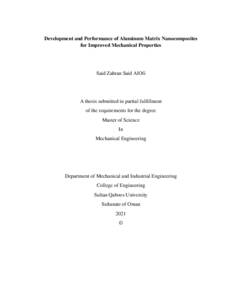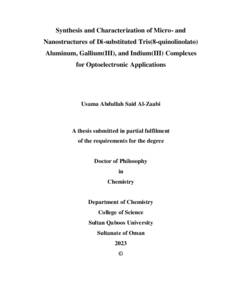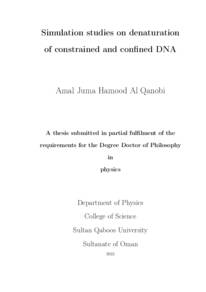Document
Development and performance of aluminum matrix nanocomposites for improved mechanical properties.
Publisher
Sultan Qaboos University.
Gregorian
2021
Language
English
English abstract
Aluminum matrix composites offer superior properties that can substitute traditional
materials in the automotive industry. This study aims to investigate the performance of
aluminum-based metal matrix composites with nanoparticles used as reinforcement made
by stir-squeeze casting for improved mechanical properties. This nanocomposite could be
used in many applications, including a brake rotor application where superior mechanical
properties are required. The type of reinforcement, particle size, and weight percentages
are determined using previous studies. The nanocomposite material is subjected to a
standard T6 heat treatment to enhance the performance of the nanocomposite. The
nanocomposite is also subjected to a hot extrusion process to enhance its mechanical
properties. The characterization includes obtaining materials chemical mechanical
properties (using optical and scanning electron microscope (SEM), energy-dispersive X ray spectroscopy (EDS), X-rd diffraction (XRD)), mechanical properties (hardness and
compressive strength), physical properties (density and porosity), and tribological
properties (wear rate).
The results show that the presence of nanoparticles affects the nanocomposite mechanical
properties (hardness and wear resistance). Furthermore, the presence of porosity and
agglomerated particles (confirmed by SEM) also affected the material's strength.
Compared to the base alloy, hardness is improved by 19.5 % and 37.55% for cast
nanocomposite and heat-treated nanocomposite. Moreover, post processing of stir squeeze
casted nanocomposites using hot extrusion refined the grains and improved the hardness
by 27.4%. The ultimate compressive strength of the Al 7075 matrix and as-cast
nanocomposite were comparable. However, the nanocomposite had lower strength due to
the porosity and particle agglomeration. T6 heat treatment showed the best results in terms
of hardness and compressive strength, and this is due to the presence of η' (MgZn2)
formed during aging. On the other hand, extruded nanocomposite had the lowest strength,
and this is due to the T(Al-Zn-Mg-Cu) phase, which is most likely the result of dynamic
precipitation caused by hot extrusion formed at a high temperature (400°C) despite the
observed grain refinement after hot extrusion.
Member of
Resource URL
Arabic abstract
تُوفر ُمركبات الألمنيوم خصائص فائقة يُمكن أن تحل محل المواد التقليدية في صناعة السيارات. تهدف هذه الدراسة إلى التحقق من أداء المركبات المعدنية القائمة على الألمنيوم مع المواد النانونية )المستخدمة كتعزيز( والتي يتم صنعها بواسطة عملية الصب )الانضغاط ال ُمح رك) لتحسين الخواص الميكانيكية. يمكن استخدام هذا المركب في العديد من التطبيقات ، بما في ذلك الفرامل ذات الخصائص الميكانيكية الفائقة. يتم تحديد نوع المكونات النانونية، حجمها، ونسب الوزن بإستخدام الدراسات السابقة. كما ستخضع ُمركبات الألمنيوم النانو نية للمعالجة الحرارية لتحسين الاداء بما كانت عليه قبل المعالجة الحرارية(. )مقارنة سيخضع المركب النانوني أي ًضا لعملية بثق ساخنة لتعزيز خصائصه ً الميكانيكية. سيتم تحديد الخصائص من عدة نواحي تتضمن المواد )البصرية، المجهر الالكتروني الماسح ، مشتَّ الطاقة ، و انعراج الاشعة السينية ( ، الخواص الميكانيكية )الصلابة و قوة الضغط( ، الخواص الاشعة السينية ت ة الفيزيائية )الكثافة والمسامية( ، وخصائص علم الاحتكاك )معدل التآكل(. أظهرت النتائج أن وجود الجسيمات النانون ية تؤثر على الخواص الميكانيكية )الصالبة ومقاومة التآكل(. عالوة على ذلك ، فإن وجود المسامية والجسيمات المتكتلة )التي أكدها المجهر الالكتروني الماسح( أثر أي ًضا على قوة الُمركب. كان العامل الرئيسي الذي أثر على المركب النانوني هو نوع طور المصفوفة ، حيث لعبت دو ًرا مهًما في تحديد الخواص الميكانيكية للُمركب ، وتم تأكيد كل طور باستخدام انعراج الاشعة السينية . بالمقارنة مع السبائك الاساسية ، تم تحسين الصلابة بنسبة ٪19.5 و ٪37.55 للُمركبات النانو نية المصبوبة وال ُمركبات النانو نية المعالجة بالحرارة. في الجهة المقابلة ، فإن عملية البثق نعمت الحبيبات وتم تحسين الصالبة بنسبة .٪27.4 كانت قوة الانضغاط القصوى لمصفوفة 7075 Al والمركب النانوني المصبوب قابلة للمقارنة. ومع ذلك ، كان لل ُمركب النانون ي قوة أقل بسبب المسامية وتكتل الجسيمات. ظهرت المعالجة الحرارية 6T أفضل النتائج من حيث الصالبة وقوة الانضغاط ، ويرجع ذلك إلى وجود (2MgZn' (η الناتج عن درجة الحرارة ال ُمستخدمة. من ناحية أخرى ، كان للمركب النانوني المبثوق أقل قوة ، ويرجع ذلك إلى طور (Cu-Mg-Zn-Al (T ، والذي هو على الارجح نتيجة الترسيب الديناميكي الناتج عن البثق الساخن المتكون عند درجة حرارة عالية )400 درجة مئوية(.
Category
Theses and Dissertations



